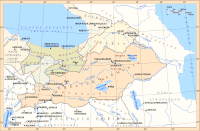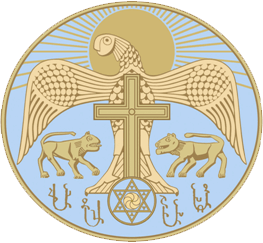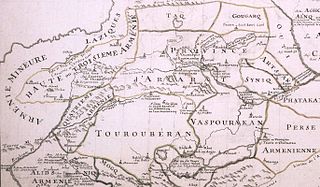Хронология армянской государственности
Хронология армянской государственности — список армянских государств и государственных образований с древних времён до наших дней.
Древний мир
Государства
- Хайаса — XV век до н. э. — XIII век до н. э.[1][2][3][4][5][6][7]
- Урарту — 860 до н. э. — 590 до н. э.[8][9]
- Айраратское царство — 331—200 гг. до н. э.
- Малая Армения — 322—115 гг. до н. э.
- Софенское царство — III век до н. э. — 94 г. до н. э.
- Великая Армения — 190 г. до н. э. — 387 г. н. э.
- Коммагена — 163 г. до н. э. — 72 г. н. э.[10][11]
Вассальные государства
- Великая Армения — 387 — 428 гг.
- Малая Армения — 115 г. до н. э.—71 г.н.э.
Средневековье
Государства
- Армянское царство Багратидов — 884/885—1045 гг.[12]
- Парисосское царство — 958 — 1003 гг.[13][14]
- Государство Филарета Варажнуни — 1071—1086 гг.[12][15]
- Киликийское армянское государство — 1080—1375 гг.[12][16]
- Кесунское княжество — 1086 — 1117 гг.
Вассальные государства и государственные образования

- Первая Армения — 378—536 гг.
- Вторая Армения — 378—536 гг.
- Третья Армения — 535—536 гг.
- Марзпанская Армения — 428 — 636 гг.[18][19]
- Армянский эмират — административная единица с 701 в составе провинции Xалифатa
- Хаченское княжество[20] — 821 — 1603 гг.
- Тайк-Кхарджк(царство Иверия с 888 г.)-881-1000 гг.
- Васпуараканское царство — 908 — 1021 гг.[12]
- Карсское царство — 963 — 1064 гг.[12]
- Ташир-Дзорагетское царство[20] — 972/979—1010/1013[12] и 1185—1261 гг.
- Сюникское царство[20] — 987 — 1170 гг.[12]
- Захаридская Армения — 1195 — 1261 гг.[21][22]
- Сюникское княжество Орбелянов[23] — 1211 — 1435 гг.
- Эдесское княжество — 1083 — 1098 гг.
- Сасун — X-XIII вв [24]
- Княжество Мелитены — 1071 — 1104 гг.
- Княжество Пир — 1086 — 1100 гг.
Новое время
Aвтономные образования
- Меликства Хамсы (в Нагорном Карабахе) — 1603—конец XVIII века[20][25][26][27] (в составе Персидской империи Сефевидов/Каджаров)
- Меликства Сюника — XV—XVIII вв.[28]
- Кашатагское меликство — XV—XVII вв.[29][30][31][32][33]
Новейшее время
- Первая Республика Армения — 28 мая 1918 — 29 ноября 1920
- Республика Горная Армения — 25 декабря 1920 — 9 июля 1921
- Социалистическая Советская Республика Армения — 29 ноября 1920 — 5 декабря 1936
- Армянская Советская Социалистическая Республика — 29 ноября 1920 — 21 сентября 1991
- Республика Армения — с 21 сентября 1991
- Непризнанная Нагорно-Карабахская Республика — с 2 сентября 1991
Галерея
 Царство Хайаса (XVI—XIII вв. до н. э.)
Царство Хайаса (XVI—XIII вв. до н. э.) Армения на древнейшей римской карте Помпонии Мела, I век до н. э.
Армения на древнейшей римской карте Помпонии Мела, I век до н. э. Карта Птолемея
Карта Птолемея Армянское царство в эпоху Ервандидов, IV—II вв. до н. э.
Армянское царство в эпоху Ервандидов, IV—II вв. до н. э. Армения, Месопотамия, Вавилон и Ассирия с прилегающими регионами. Карл фон Шпрунер, опубликована в 1865 году.
Армения, Месопотамия, Вавилон и Ассирия с прилегающими регионами. Карл фон Шпрунер, опубликована в 1865 году. Великая Армения в I—IV веках, по карте-вкладышу ко II тому «Всемирной истории» (М., 1956) (Заштрихованы земли Великой Армении, отошедшие от неё к соседним государствам после раздела в 387 году). В центре Марзпанская Армения V—VIII века
Великая Армения в I—IV веках, по карте-вкладышу ко II тому «Всемирной истории» (М., 1956) (Заштрихованы земли Великой Армении, отошедшие от неё к соседним государствам после раздела в 387 году). В центре Марзпанская Армения V—VIII века Провинции Великой Армении. George Whiston, опубликована в 1736 году
Провинции Великой Армении. George Whiston, опубликована в 1736 году Киликийское армянское государство, 1080—1375 гг.
Киликийское армянское государство, 1080—1375 гг. Сюникское царство в 1020—1166 годах
Сюникское царство в 1020—1166 годах Первая Республика Армения
Первая Республика Армения
См. также
Примечания
- ↑ P. Kretschmer. Der nationale Name der Armenier Haikh // Anzeiger der Akademie der Wissenschaften in Wien. Philosophisch-historische Klasse 69, 1932
- ↑ Г. Б. Джаукян. О соотношении хайасского и армянского языков // Պատմա-բանասիրական հանդես. — 1988-05-06. — Т. № 1. — С. 60–79. — ISSN 0135-0536. Архивировано 11 июля 2020 года.
- ↑ Г. Б. Джаукян. О соотношении хайасского и армянского языков // Պատմա-բանասիրական հանդես. — 1988-09-01. — Т. № 2. — С. 68–88. — ISSN 0135-0536. Архивировано 12 июля 2020 года.
- ↑ Большая советская энциклопедия. Армяне. Дата обращения: 23 апреля 2020. Архивировано 19 января 2021 года.
- ↑ Армяне. Серия «Народы и культуры». / отв. ред. Л. М. Варданян, Г. Г. Саркисян, А. Е. Тер-Саркисянц; Ин-т этнологии и антропологии им. Н. Н. Миклухо-Маклая РАН; Ин-т археологии и этнографии HAH РА. — М. : Наука, 2012., 48-51.
- ↑ Вяч Вс Иванов. Выделение разных хронологических слоев в древнеармянском и проблема первоначальной структуры текста гимна Ва(х)агну // Պատմա-բանասիրական հանդես. — 1983-12-26. — Т. № 4. — С. 22–43. — ISSN 0135-0536. Архивировано 28 сентября 2020 года.
- ↑ Гамкрелидзе Т.В., Иванов Вяч.Вс. Индоевропейский язык и индоевропейцы. Реконструкция и историко-типологический анализ праязыка и протокультуры.. — Тбилиси: Издательство Тбилисского университета, 1984. — С. 912—913. — 1328 с.
- ↑ Wade, Nicholas (2015-03-10). "Date of Armenia's Birth, Given in 5th Century, Gains Credence". The New York Times. Архивировано 28 августа 2020. Дата обращения: 24 сентября 2020.
- ↑ Marc Haber, Massimo Mezzavilla, Yali Xue, David Comas, Paolo Gasparini. Genetic evidence for an origin of the Armenians from Bronze Age mixing of multiple populations (англ.) // bioRxiv. — 2015-02-18. — P. 015396. — doi:10.1101/015396. Архивировано 12 октября 2020 года.
- ↑ Frank McLynn (2010). Marcus Aurelius: A Life. New York: Da Capo Press. p. 377.ISBN 0786745800.
- ↑ E. Yarshater. The Cambridge History of Iran. — Cambridge University Press, 1983-04-14. — 758 с. — ISBN 9780521200929.
- ↑ 1 2 3 4 5 6 7 История армянского народа. — Ер.: Изд-во АН Арм. ССР, 1976. — Т. III. — С. 972—978. Архивировано 5 марта 2016 года.
- ↑ Bussell Frederick William. The Roman Empire: Essays on the Constitutional History from the Accession of Domitian (81 A. D.) to the Retirement of Nicephorus III (1081 A.D.). — Longmans, Green, 1910. — P. 462.
- ↑ Balayan Vahram. Artsakh History from Time Immemorial Up to Our Days. — 2005. — P. 90—91.
- ↑ В. П. Степаненко. Государство Филарета Варажнунии // Античная древность и средние века. — Свердловск, 1975. — Вып. 12. — С. 86-103. Архивировано 19 апреля 2014 года.
- ↑ Падение независимости Армении. Киликийская Армения | История.ру. www.istoriia.ru. Дата обращения: 5 января 2016. Архивировано 5 февраля 2016 года.
- ↑ Туманян Л. Скриптории монастырей на островах озера Ван. — Ер., 2019. — С. 101. Архивировано 8 января 2022 года.
- ↑ Christian Settipani. Continuité des élites à Byzance durant les siècles obscurs. Les princes caucasiens et l'Empire du vie au ixe siècle. — Paris, de Boccard, 2006. — 634 с. — ISBN 978-2-7018-0226-8.
- ↑ Vahan M. Kurkjian. A History of Armenia. — «For two hundred years after the fall of the Arshakuni dynasty of Armenia in 428, the country was governed by Marzbans (Governors-general of the boundaries), nominated by the Persian King.»
- ↑ 1 2 3 4 Armenia — статья из энциклопедии Британника "The Byzantine conquest was short-lived: in 1048 Toghrïl Beg led the first Seljuq raid into Armenia, in 1064 Ani and Kars fell to Toghrïl’s nephew and heir Alp-Arslan, and after the Battle of Manzikert (1071) most of the country was in Turkish hands. In 1072 the Kurdish Shāddādids received Ani as a fief. A few native Armenian rulers survived for a time in the Kiurikian kingdom of Lori, the Siuniqian kingdom of Baghq or Kapan, and the principates of Khachen (Artzakh) and Sasun. ... In mountainous Karabakh a group of five Armenian maliks (princes) succeeded in conserving their autonomy and maintained a short period of independence (1722-30) during the struggle between Persia and Turkey at the beginning of the 18th century; despite the heroic resistance of the Armenian leader David Beg, the Turks occupied the region but were driven out by the Persians under the general Nādr Qolī Beg (from 1736-47, Nādir Shah) in 1735."
- ↑ Armenia and Georgia // The Cambridge Medieval History. — Cambridge, 1966. — Т. IV: The Byzantine Empire, part I chapter XIV. — С. 593—637.: "Later, in the twelfth and thirteenth centuries, the Armenian house of the Zachariads (Mkhargrdzeli) ruled in northern Armenia at Ani, Lor’i, Kars, and Dvin under the Georgian aegis."
- ↑ Армянское княжество Закаридов в составе Грузинского царства. www.advantour.com. Дата обращения: 30 января 2016. Архивировано 22 декабря 2015 года.
- ↑ James Stuart Olson. An Ethnohistorical dictionary of the Russian and Soviet empires. — Greenwood Publishing Group, 1994. — С. 44."The acceptance of Islam by the Mongols around 1300, the resurgence of the Turks under the Ottomans, and the European abandonment of the Levant sounded the death knell of the last Armenian kingdom, which fell to the Mamluks (or Mamelukes) in 1375. Only pockets such as Karabagh (Karabakh) and Zangezour in eastern Armenia and Sasun and Zeitun in western Armenia remained autonomous."
- ↑ Armenia — статья из энциклопедии Британника:
A few native Armenian rulers survived for a time in the Kiurikian kingdom of Lori, the Siuniqian kingdom of Baghq or Kapan, and the principates of Khachen (Artzakh) and Sasun
- ↑ Encyclopaedia of Islam. — Leiden: BRILL, 1986. — Т. 1. — С. 639-640 "Numismatic Society). were still to be fought on Armenian soil, and part of the Armenians of Adharbaydjan were later deported as a military security measure to Isfahan and elsewhere. Semi-autonomous seigniories survived, with varying fortunes, in the mountains of Karabagh, to the north of Adharbaydjan, but came to an end in the 18th century."
- ↑ Cyril Toumanoff. Armenia and Georgia // The Cambridge Medieval History. — Cambridge, 1966. — Т. IV: The Byzantine Empire, part I chapter XIV. — С. 593—637 "The title of King of Armenia was inherited by the Lusgnans of Cyprus and, from them, by the House of Savoy. Only in Old Armenia could some vestiges of the once imposing structure of the Armenian polity be found in the houses of dynasts (meliks) in Qarabagh"
- ↑ Армянская Советская Социалистическая Республика — статья из Большой советской энциклопедии (3 издание) "В 1639, после мира, заключённого между Турцией и Ираном, А. была окончательно разделена: Западная А., составляющая большую часть страны, отошла к Турции, Восточная А. — к Ирану. Последними остатками армянской государственности являлись 5 меликств Нагорного Карабаха, просуществовавших до конца 18 в."
- ↑ Malkasian, Mark. Gha-ra-bagh!: The Emergence of the National Democratic Movement in Armenia.. — Wayne State University Press. — 1996. — С. 19. — ISBN 0814326056."Following the disastrous fall of the Armenian Kingdom of Cilicia to the Mamluk Sultanate of Cairo in 1375 and the invasion and pillage of Armenia proper by Tamerlane in 1400, only four territories - the highlands of Artsakh (Karabakh), Syunik (Zangezur), few isolated towns around Lake Sevan and the villages of the highlands of Mush and Sasun near Lake Van remained where Armenians retained some degree of autonomy and self-rule. The most important, long lasting and well-developed of these were the various principalities of Syunik and Artsakh ruled by several princely houses that had the title of melik bestowed upon them."
- ↑ Карагезян А. К локализации гавара Кашатаг // Вестн. обществ. наук АН АрмССР. 1987. № 1. С. 44—45. .
- ↑ Кристине Костикян «Քաշաթաղի 17-րդ դարի պատմությանը վերաբերող մի փաստաթուղթ» (Документ относящийся к истории Кашатага в 17 веке) из «Страны и народы Ближнего Среднего Востока. Том XX», стр. 168—171. Институт востоковедения Национальной Академии наук Армении; Ереван, 2001. .
- ↑ Encyclopaedia of Islam. — Leiden: BRILL, 1986. — Т. 1. — С. 639-640.
- ↑ ARTAK GHULYAN. CASTLES (PALACES) OF MELIKS OF ARTSAKH AND SIUNIK. — «It refers to Melik-Haykaz the First (1450 - 1520), the founder of melikal principality of Kashatagh and is dated the end of the 15th cent.» Дата обращения: 30 января 2016. Архивировано из оригинала 29 сентября 2020 года.
- ↑ Michael P. Croissant, The Armenia-Azerbaijan conflict: causes and implications, p.11: Importantly, disunion amongst the five princes allowed the establishment of a foothold in mountainous Karabakh by a Turkic tribe around 1750. This event marked the first time that Turks were able to penetrate the eastern Armenian highlands…
Литература
Книги
На русском языке
- Абаза В.А. История Армении. — 2-е изд.. — СПб.: Типография И.Н. Скороходова, 1888. — 129 с.
- Глинка С. Н. Обозрение истории армянского народа от начала бытия его до возрождения области Армянской в Российской Империи. — Часть 1. — М.: Типография Лазаревых Института восточных языков, 1832. — 294 с.
- Глинка С. Н. Обозрение истории армянского народа от начала бытия его до возрождения области Армянской в Российской Империи. — Часть 2. — М.: Типография Лазаревых Института восточных языков, 1833. — 273 с.
- И. Джавахов. Государственный строй древней Грузии и древней Армении. — СПб.: Тип. Имп. академии наук, 1905. — Т. 1.
- Анания Ширакаци. Армянская география VII в. по Р. Х. (приписывавшаяся Моисею Хоренскому). Пер. с др.-арм. и коммент. К.П.Патканова. Вступит. ст. К.П.Патканова. = Աշխարհացույց. VII վ. — СПб.: Типография Императорской Академии Наук, 1877.
- Хачикян А.Э. История Армении. Краткий очерк. — 3-е изд., перераб. и доп.. — Ер.: Эдит Принт, 2016. — 311 с. — ISBN 978-9939-52-083-4.
- Еремян С.Т. Армения согласно "Географии" 7-го века = Հայաստանը ըստ «Աշխարհացոյց». — Ер., 1963.
- Фавстос Бузанд. История Армении / Еремян С.Т.. — Ер.: АН АССР, 1953. Так же доступна на сайте vehi.net.
- М. Хоренский. История Армении. Перевод Н.О. Эмина (с примечаниями и приложениями).. — М.: Типография В.А. Гатцук, 1893. — 363 с.
- Мовсес Хоренаци. История Армении / Пер. с древнеарм. языка, примечания Г. Саркисяна; Ред. С. Аревшатян. — Ер.: Айастан, 1990.
- В.Г. Тунян. Фальсификация истории восстановления армянской государственности в азербайджанской историографии. — Ер.: ЕГУ, 2018. — С. 396. — ISBN 978-5-8080-2314-5.
На английском языке
- Robert H. Hewsen. Armenia: A Historical Atlas. — University of Chicago Press, 2001.
- Robert H. Hewsen. The Geography of Ananias of Sirak (ASXARHACOYC). — Reichert, 1992. — 501 p.
- Elizabeth Redgate. The Armenians (1st ed.). — Oxford, UK: Blackwell Publishers, 2000. — 352 с. — ISBN 9780631220374.
- Richard G. Hovannisian. Armenia on the Road to Independence (англ.). — University of California Press, 1967. — 364 p.
- George A. Bournoutian. Armenian // An Ethnohistorical Dictionary of the Russian and Soviet Empires / James Stuart Olson, Lee Brigance Pappas, Nicholas Charles Pappas. — Westport, Conn.: Greenwood press, 1994. — 840 p. — ISBN 9780313274978.
- Simon Payaslian[англ.]. The History of Armenia: From the Origins to the Present. — NY: Palgrave Macmillan US, 2008. — 294 p. — ISBN 9780230608580.
- Christopher J. Walker. The Armenian presence in mountainous Karabakh // Transcaucasian Boundaries / John Wright, Richard Schofield, Suzanne Goldenberg. — Psychology Press, 2004. — 248 p. — ISBN 9780203214473.
- Ronald Grigor Suny. Looking toward Ararat: Armenia in modern history. — Bloomington and Indianapolis: Indiana University Press, 1993. — 289 p. — ISBN 0253207738.
- Joseph R. Masih, Robert O. Krikorian. Armenia At the Crossroads (англ.). — Amsterdam: Harwood Academic Publishers, 1999. — 142 p. — ISBN 9789057023446.
- Armenia // A Political Chronology of the Middle East / David Lea, Annamarie Rowe, Dr. Isabel Miller. — First edition. — UK: Psychology Press, 2001. — 282 p. — ISBN 9781857431155.
- Arminiya // The encyclopedia of Islam / H. A. R. Gibb, J. H. Kramers, E. Levi-Provençal, J. Schacht, B. Lewis, Ch. Pellat. Assisted by S. M. Stern (pp. 1—330), C. Dumont and R. M. Savory (pp. 321—1359). — Leiden, Netherlands: E.J. Brill, 1986. — Vol. I. A-B. — P. 634—650. — 1359 p. — ISBN 90-04-08114-3.











